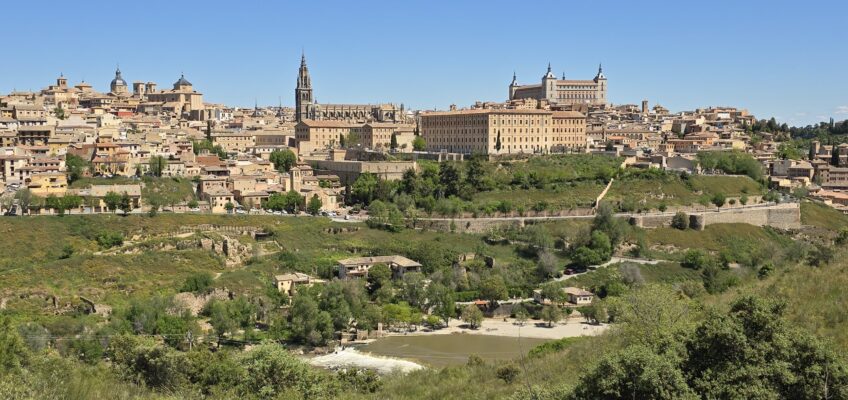I spent three nights in Toledo at the tail end of the third and final OAT tour of this three-month excursion in Iberia and Morocco. All that’s left are Granada (where I am now as I write this) and Madrid. A week from today I go home.
Since I’ve allowed two days to pass since I left Toledo, I’m going to summarize briefly and let my photos do most of the talking.
Day One in Toledo
On the drive from Úbeda, we had a comfort stop at a place called “Casa Pepe.” Laura, our trip leader, warned us in advance that this is owned and run by people who harbor longing for the days of Francisco Franco, the cruel dictator who ruled Spain for more than thirty years. I considered not going in, because nostalgia for authoritarianism is not a virtue I am comfortable with, especially in the days of Trump. But I did go in, and I found the whole thing not so much upsetting as silly. Unlike in the USA, I don’t think this sort of thing will find any traction in Spain.
We also passed a lot of windmills. This is La Mancha, the land of Don Quixote, a fact we saw many remindeers of during our visit to Toledo.
On our way into the city we stopped at the viewpoint across the Tagus River (same river that flows out to the sea at Lisbon). That’s the photo at the top of the page.
That afternoon, after arriving in Toledo, having lunch, and settling into our hotel, we had a walking tour of the city. The absolute highlight of this was seeing El Greco’s masterwork, “El Entierro del Señor de Orgaz” (The Burial of the Count of Orgaz), at Iglesia de Santo Tomé.
Our local guide, Carlos, gave us a excellent analysis, and I’ve shared some of that in the caption in my photo album.
Day Two in Toledo
The group activity was a day trip to Madrid, but since I’m going there on my own, I opted to spend the day in Toledo. This was the day of the massive nationwide power outage, which I already wrote about.
The day’s activities included visits to the Museo de Santa Cruz and the Cathedral, where I was when the power went off. Then lunch at a restaurant that only served cold items and was cash only (because no power or internet), a walk around the city down by the river, and a nap filled the afternoon until the group made it back from Madrid.
Lots more photos of the Cathedral are in my album.
Day Three in Toledo
Flamenco
We started our day with a flamenco show and Q&A in our hotel. I previously attended a flamenco show in Seville, and while this wasn’t quite as spectacular, it was interesting to be able to hear the performers describe the style and character of the music and dance.
Damasquine
Then Laura took us to a local, family-run shop to see how Damasquine is made. We watched the craftsmen, father and sun, working with fine silver and gold thread and gold leaf, hammering it into stainless steel to create intricate patterns. This beautiful work is available in shops all over the city. Not all of it is handmade, though, and the best handmade items are very expensive (hundreds of dollars for small ornamental plates).
Contemporary Art
After that I struck out on my own, as I had a lot of sites I wanted to see. I was heading for the Jewish Quarter, but I got diverted when I passed Centro Cultural de San Marcos, an art gallery housed in a former church. It turned out to have a fascinating collection of contemporary art.
Jewish Quarter
I did finally make it to the Jewish Quarter, where I visited Sinagoga del Tránsito y Museo Sefardí and Santa María la Blanca Synagogue. Both of these date from the Muslim era in Toledo. Muslim craftsmen built both synagogues, and both became Catholic churches after the Jews were expelled. Architecturally there are few reminders of their Jewish past. In fact, the designs are Mudéjar, and while neither of these buildings was ever a mosque, that’s the sense I got entering both of them.
I also visited the El Greco Museum and the Monastery of San Juan de los Reyes. Lots of photos and descriptions are in my album. I feel like I’ve already written enough, and Granada awaits.
Oh yeah, we had our farewell dinner that night, and we all said our good-byes.


Liz Simon
Lane: Thank you for sharing your journey and photos of the Paradores and Pousadas trip (I was on that tour last year). It is always interesting to see how the different tour guides highlight different things. I’ve enjoyed your posts and photos immensely! Thank you!
Lane
Thanks Liz! I’m glad you enjoyed reliving the tour!
Sharon Eilertson
As usual Your description and photos make me feel like I as there enjoying them too!! Thanks again. Safe travels!!!
Lane
Thank you Sharon! And happy travels to you Cary, wherever you may go!